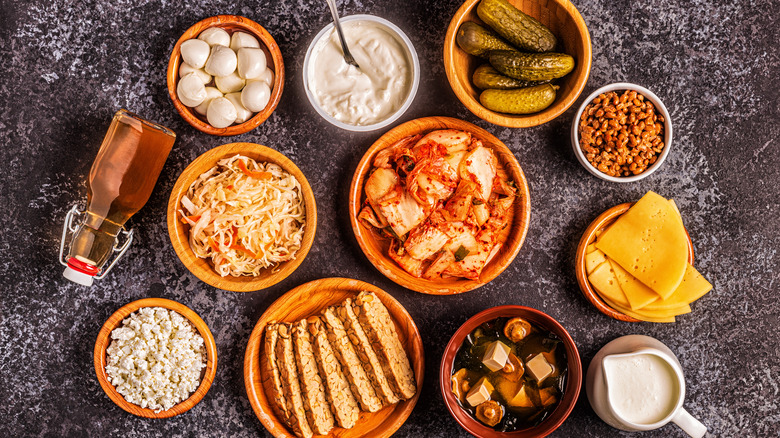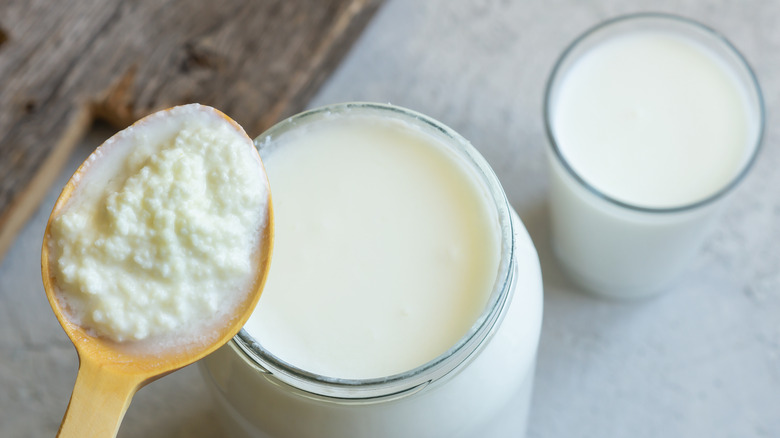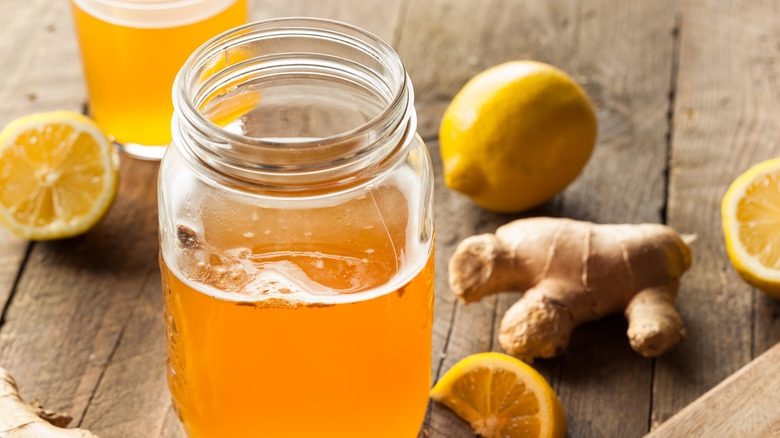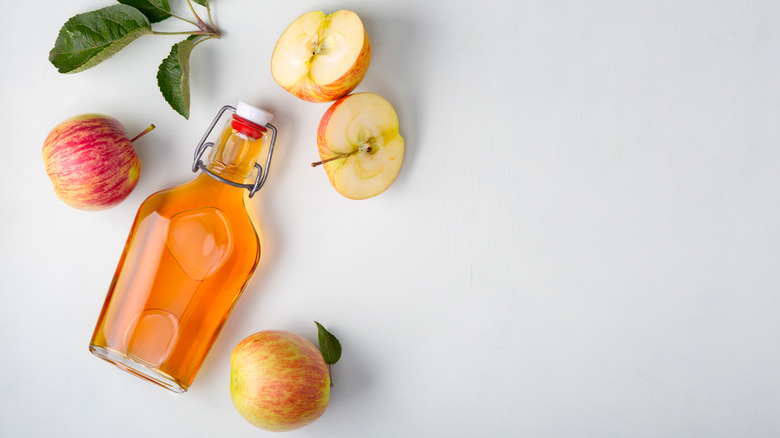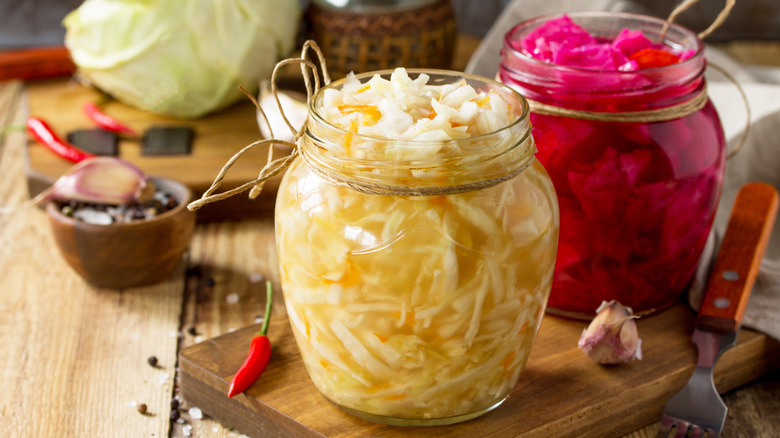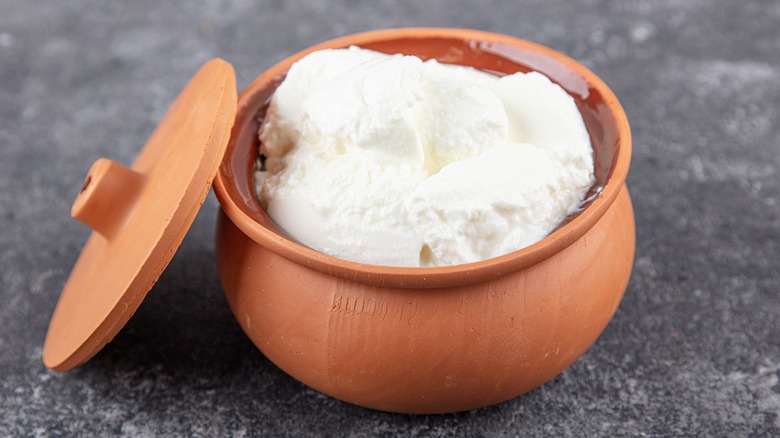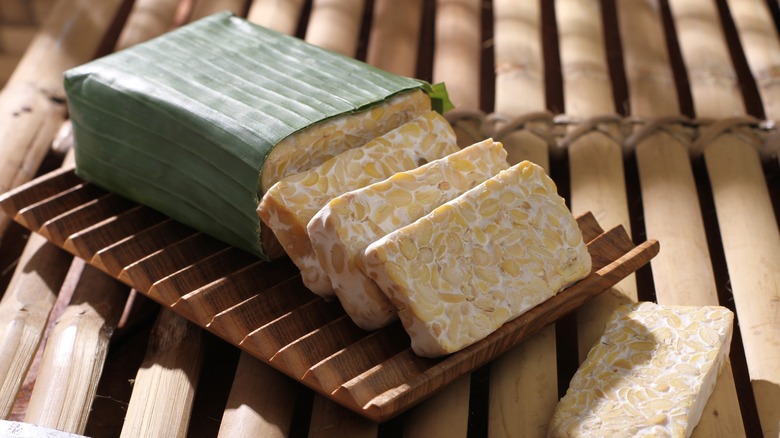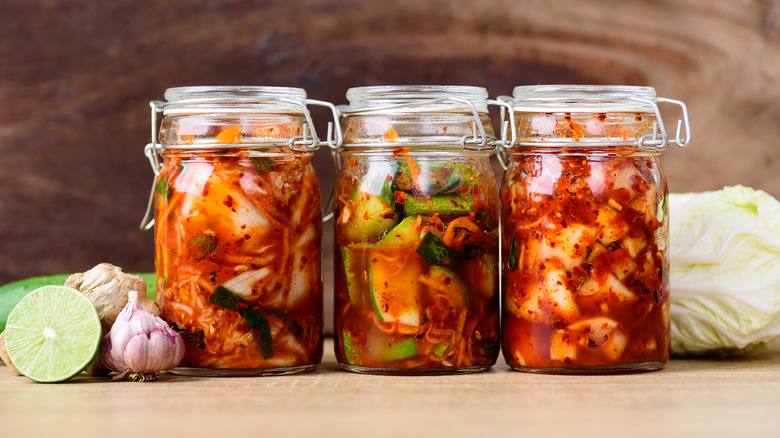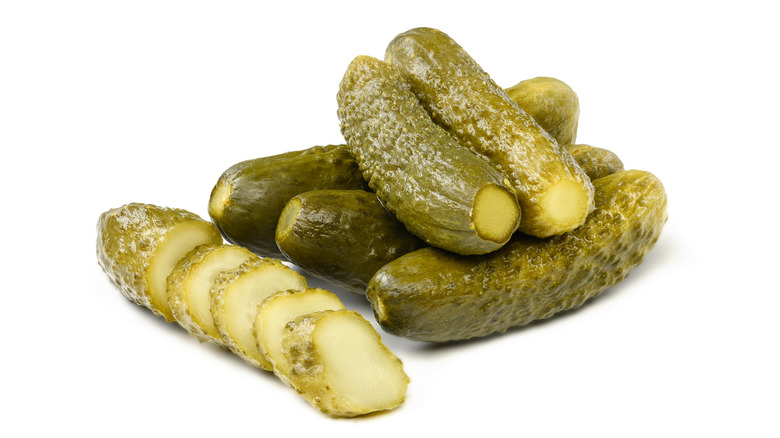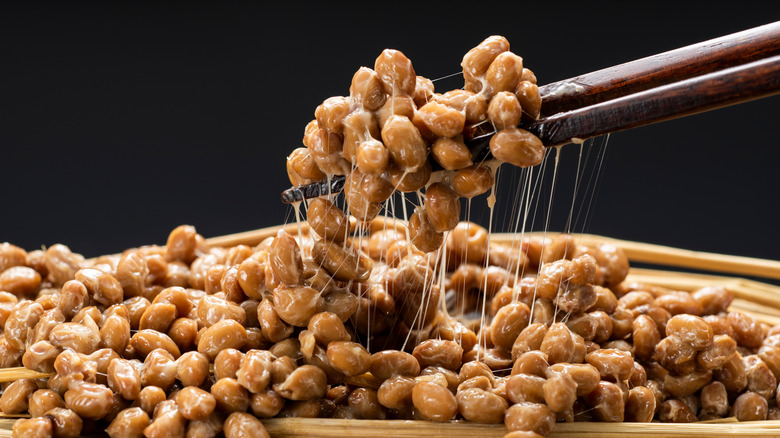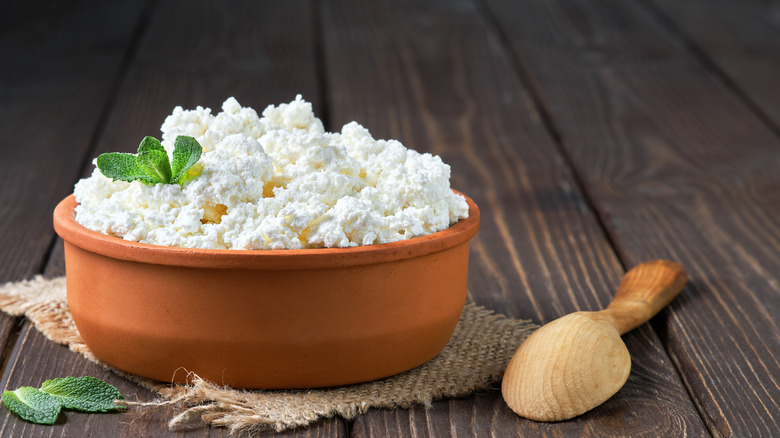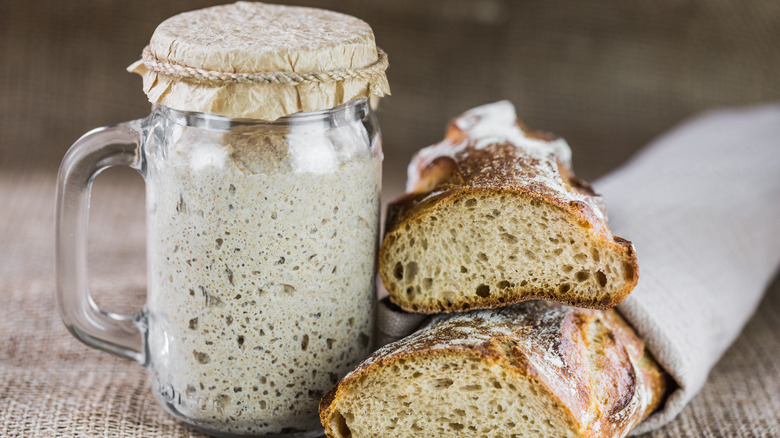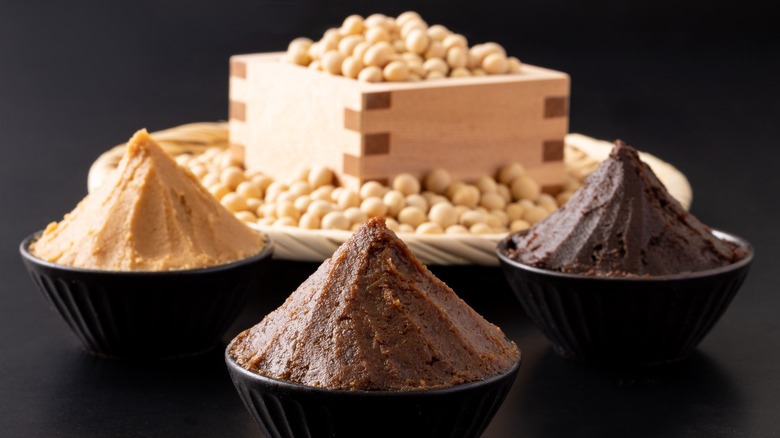13 Fermented Foods And Sneaky Ways You Can Cook With Them
Fermented foods seem to be the new hip thing on the foodie scene, with restaurants and grocers advertising all kinds of items ranging from homemade pickles to the house kombucha. Yet the consumption of fermented foods is a centuries-old practice, having evolved out of the necessity of prolonging the shelf life of foods and eliminating the potential for contamination with harmful toxins (via the New Zealand Heart Foundation). Virtually any food can be fermented by encouraging the breakdown of its naturally occurring sugars and carbohydrates by bacteria, yeast, or other microorganisms, per Dr. Axe. The key is to do this in a controlled environment.
Purported benefits of consuming fermented foods have to do with the proliferation of probiotics within them (per the NZ Heart Foundation). These naturally occurring bacteria are not only integral to gut health but can influence every aspect of your body. Research has shown compelling evidence of probiotics improving cardiovascular health, reducing inflammation, aiding in weight management, and even regulating mood. The primary factor in the level of probiotics within a fermented food has to do with whether or not the item has been pasteurized after fermentation, which will kill all bacteria in the fermented food, including these powerful probiotics.
Clearly we should all be incorporating more fermented foods into our diets on a regular basis. As such, we decided to create a list of commonly fermented foods and the sneaky ways in which you can implement them into your culinary creations.
1. Kefir
Kefir is a fermented milk beverage that has been consumed by nomadic tribes throughout parts of Eurasia north of the Caucasus Mountains for centuries. Its name comes from the Turkish "keyif," which translates to "feeling good." It is traditionally produced through the introduction of kefir "grains," which promote lacto-fermentation in the milk. According to WebMD, kefir can contain up to 30 distinct strains of probiotics and is particularly rich in magnesium.
While you can obtain kefir in a number of delicious flavors from a myriad of different brands, it can be an amazing ingredient to incorporate into baking, particularly as a substitute for buttermilk. Like buttermilk, kefir has one superpower: its acid content (via America's Test Kitchen). When baking soda is exposed to an acidic liquid like kefir, it produces carbon dioxide, causing your baked goods to become leavened and fluffy. It also adds a unique tangy flavor, which is particularly desirable in recipes like pancakes and quick breads. It is especially effective at making gluten-free baked goods less dense. We recommend substituting it for the buttermilk in this delicious gluten-free cornbread recipe.
2. Kombucha
Tea has long been fermented by numerous cultures from China to Italy. Known as kombucha, this unique carbonated beverage develops its bubbles through the incorporation of sugar and a culture known as a SCOBY, or Symbiotic Culture of Bacteria and Yeast, into the tea. As the liquid ferments, a small percentage of alcohol is produced, approximately 0.5%, along with an abundant quantity of those health-promoting probiotics which make fermented foods and beverages so nutritious (via WebMD).
Like with kefir, many manufacturers have gotten into the kombucha business, selling flavors like Cosmic Cranberry and Mystic Mango. However, kombucha can be a particularly expensive habit to develop at up to $5.00 for a 16-ounce bottle. But if you'd like to incorporate kombucha into your daily routine, there are some clever ways to do so. Our favorite involves using it as a substitute for acidic components in alcoholic mixed beverages. It is a great low-sugar option in place of soda or sweet and sour mix in any cocktail, like this whiskey ginger mash.
Additionally, much like soda, kombucha can be a stellar addition to a meat marinade. The high acidity will act as a tenderizer to break down the dense protein fibers in meat while simultaneously imparting a great flavor. Just be sure to combine it with something else that will provide some umami punch, like soy sauce or Worcestershire sauce. And, don't over-marinate meat, as it may end up becoming mushy.
3. Apple cider vinegar
For centuries, vinegar has been a staple of the diets and lifestyles of cultures across the globe (via Freedom of Health). Its antibacterial, anti-microbial, and antiseptic qualities are widely recognized as integral to good health. Apple cider vinegar in particular has seen a resurgence in popularity as a health food fad in recent years, partly thanks to a trend toward the incorporation of natural medicinal remedies and largely because of its utility.
Its production is simple. The fruit is crushed and is left to sit for weeks as it naturally ferments, turning it into alcohol. This apple wine is then strained, and the alcohol is allowed to ferment for another few weeks until it is converted into vinegar by the bacteria and enzymes known as the "mother." If you've ever opened a bottle of wine that has "turned," this is essentially what has occurred in the bottle.
As far as culinary uses for apple cider vinegar, the obvious first choice is to turn it into a vinaigrette for a salad. But a more sneaky use for apple cider vinegar is as an ingredient in baked goods, particularly vegan baked goods (via The Takeout). The key is the way in which the acid in vinegar interacts with baking soda to create carbon dioxide. When eggs are removed from a recipe, baked goods can tend to be dry and dense. Apple cider vinegar can combat this perfectly by producing effervescence to lighten your vegan cakes.
4. Sauerkraut
While the fermented cabbage known as sauerkraut may bring up fond memories of beer and brats consumed during Oktoberfest, the origins of this incredibly healthful condiment actually date back more than 2,000 years to China (via Healthline). Indeed, the Chinese recognized the utility of fermentation as a means of prolonging the shelf life of vegetables, like cabbage. The Chinese weren't the only ones, as ancient Romans also pickled cabbage in salt and vinegar. And sauerkraut was commonly consumed by seafaring individuals beginning in the 18th century, as a way of warding off the scourge of scurvy.
Pungent aroma aside, as Healthline notes, sauerkraut's superpower lies in its nutritional punch. Like other fermented foods, it is loaded with probiotics. However, cabbage is also rich in antioxidants and vitamin K, which has been known to not only promote cardiovascular health but also bone health. The key is to purchase unpasteurized versions without any preservatives or added sugars. It is also important that those watching their sodium intake note that sauerkraut can be rather high in sodium, but rinsing it prior to consumption can mitigate this.
Some sneaky ways of incorporating sauerkraut into your culinary creations include adding it into smoothies, putting it in mashed potatoes or potato salad, and adding it atop your homemade pizza. But perhaps the most unique recipes involve sauerkraut cakes, which may sound bizarre, but the sauerkraut lends moisture as well as a sour, salty contrast to sweet ingredients like chocolate. It's a match made in cabbage heaven.
5. Yogurt
According to BC Dairy, the earliest known specimens of yogurt date back 7,000 years to Mesopotamia. Recovered Neolithic-period amphorae indicate that milk was being stored in these earthenware containers for safekeeping. It is likely that bacteria permeated these samples, resulting in the fermentation of the milk and the accidental invention of yogurt. Yogurt today is produced by the introduction of yogurt cultures into milk, which causes lactic fermentation (via Healthline). The resulting thickened, tangy product is chock-full of probiotics, calcium, vitamin B12, phosphorus, magnesium, and potassium.
As far as using yogurt in cooking, the possibilities are practically endless. Sure, it's great in dips, marinades, sauces, and even as a leavening agent for your baked goods, but where we really love using it is as a supplement to cheese in an ultra-creamy homemade macaroni and cheese. Not only will this increase the protein content of your mac and cheese, but the tangy flavor is a great complement to some more exotic melting cheeses like gruyere, asiago, or even a Mexican Queso Chihuahua. And for a healthy alternative to ice cream, try making a variation of a yogurt popsicle. Your kids will love them.
6. Tempeh
Plant-based protein options are becoming more and more popular, even among non-vegetarians, as people are discovering not only the environmental impact of reducing meat consumption but also the potential health benefits (via WebMD). This is why tempeh is having a bit of a renaissance. A fermented product typically made with soybeans, although occasionally produced using other legumes, tempeh originated centuries ago in Indonesia. It is considered a complete protein (meaning it contains all nine essential amino acids needed by your body), is high in a myriad of vitamins and minerals, is loaded with probiotics, and is replete with isoflavones, which have been shown to have cancer-fighting properties.
Even though tofu is also made with soybeans, namely soy milk, it is not considered to be as healthy as tempeh, which has twice as much protein per ounce. Tempeh is made by boiling soaked hulled soybeans and then fermenting them with a starter culture for 24 hours. This results in a product that is far denser and easier to slice than tofu and has a rich umami-forward flavor.
Certainly tempeh can be cut up and used in many recipes as a meat substitute, but some of our preferred methods of cooking it include using it instead of chicken in nuggets and adding it into an Asian-style hot pot paired with rice noodles and a fair amount of chili peppers for a pop of flavor.
7. Kimchi
Per WebMD, kimchi has been produced in South Korea for over 2,000 years. This fermented vegetable slaw is historically brined in a combination of garlic, ginger, chili, and fish sauce in a cool pit where the pace of fermentation can be carefully monitored. Beyond being a natural way of preserving otherwise perishable vegetables, kimchi is loaded with vitamins, minerals, probiotics, and antioxidants. It is no wonder that it is considered the national dish of South Korea.
Adding kimchi to almost any dish can infuse it with a spicy hit of flavor, but it is particularly popular as a garnish on things like Asian noodle dishes, stir fries, and soups. Some of the more unusual uses that we love include adding it to mashed potatoes, putting it in your grilled cheese sandwich, using it as a pizza topping, and incorporating it into your scrambled eggs. And if you really want to go big or go home, try infusing it in your next cocktail recipe, stirring it into your breakfast oatmeal for a savory twist, or topping your ice cream cone with it. While it may not be for everyone, the combination of sweet with savory is a flavor mash-up that appears in cultures across the globe.
8. Pickles
The process of pickling in an acidic brine can be traced back as far as 4,000 years ago to ancient Mesopotamia, when cucumbers were preserved both for health reasons and to prolong shelf life (via History). However, making pickles by soaking them in an acidic brine is not the same as fermenting pickles, and this distinction can influence their flavor and their nutritional profiles, per WebstaurantStore. Typically, fermented pickles are produced using an anaerobic method, meaning there is little to no oxygen present in the fermentation process, which inhibits the fermented food from spoiling.
According to Healthline, fermented pickles are so desirable because they are replete with probiotics, anticancer properties, and anti-inflammatory features and can assist with insulin resistance. And lest you think the only food that can be turned into a pickle is the lowly cucumber, virtually any food can be fermented into a pickle, including fruits, meats, and even fish. Even within the world of cucumbers, the types of pickles available are incredibly diverse.
Certainly they're a great salty-sour addition to a range of coleslaws, dips, sauces, and salads, but pickles are also a surprising addition atop a pizza, in bread, in hummus, and even in a soup. However, where they really shine is when you use pickle juice in cocktails. Not only is the flavor a great addition, but according to the Cleveland Clinic, pickle juice is something of a miracle liquid which, among other things, can help cure a hangover.
9. Natto
Natto, or fermented soybeans, have long been a staple of Japanese culture, per Healthline. This product has been described as being slimy, stringy, sticky, nutty, foul smelling, and an acquired taste. While this may not seem like something you'd want to add to your culinary routine, it's popular in Japan for a reason. When consumed properly, it is a nutritional powerhouse, rife with probiotics, vitamins, minerals, and fiber. It also contains fewer antinutrients compared with unfermented soy products like tofu.
Typically the process of producing natto involves boiling the soybeans, inoculating them with the B. subtilis bacteria, and then allowing them to ferment in Styrofoam boxes. The Japanese usually consume natto as part of a healthy breakfast, although it can be eaten at any time of the day, garnished with soy sauce or mustard and served over rice. Because of its unusual texture, we recommend using it in a cooked dish, like a classic miso soup, where the gelatinous nature of natto can be tempered. Additionally, you could add it as a component in a meat marinade along with other strong flavors, where its umami-rich profile can shine through.
10. Cottage cheese
Like kefir and yogurt, cottage cheese is a fermented dairy product that confers a myriad of nutritional benefits when consumed as part of a healthy diet (via Healthline). The key is to find cottage cheese that contains active probiotic cultures, such as Nancy's Organic or Breakstone's LiveActive. Cottage cheese also comes in various curd sizes ranging from small to large, which is strictly a personal preference contingent on the mouthfeel you enjoy. Additionally, it can be found in low-fat, low-sodium, and lactose-free iterations.
In culinary circles, cottage cheese has grown in popularity, appearing on restaurant menus across the country. Because of its distinct slightly sour yet creamy flavor, it can be a great alternative to cheeses like ricotta, fresh mozzarella, or crème fraîche in virtually any recipe. However, where we love it the most is in pancakes and waffles. Not only does adding cottage cheese amp up the protein of these high-carb breakfast items, but its acidity helps to leaven these recipes, making them extra light and fluffy.
11. Wine
One of the most quintessential examples of a fermented food item is wine. Its origins date back to early Neolithic China between 7000 and 6600 B.C. (via ThoughtCo.). Its production has since spread to virtually every corner of the globe, with wine cultivation and consumption being an integral part of the cultural identities of many populations. According to WebMD, while wine can have adverse effects in those who overindulge due to its intoxicating properties, there has been some research that shows it can have a number of positive health benefits when consumed in moderation.
When it comes to cooking with wine, its applications are multifold, ranging from supplementing moisture loss due to cutting fat in a recipe to tenderizing everything from meat to vegetables (via WebMD). The key is knowing which wine to use. A basic rule of thumb is to never use a wine you wouldn't drink. Additionally, don't use wines labeled as "cooking wines," as they are loaded with sodium.
Other considerations include using a dry wine for savory dishes and sweet wines in baking, choosing tannic wines (like a chianti) for use when braising high-protein foods, and carefully selecting whether you opt for white or red wine in a recipe. Typically white wines are used for lighter foods (like fish, seafood, or chicken), while red wine is reserved for richer dishes (like game, beef, or lamb). And finally, make sure you completely cook the alcohol off when cooking with wine; otherwise your dish can have an unpleasant flavor.
12. Sourdough bread
According to Healthline, sourdough is thought to have first appeared in ancient Egypt around 1500 B.C. What makes sourdough bread so unique is its use of a combination of a wild yeast, lactic acid, flour, and water to create what's known as a "starter" to leaven the bread, as opposed to commercially obtained baker's yeast. Because sourdough bread typically takes a longer time to rise, it generally has a strong acidic flavor and odor, a by-product of the naturally occurring acetic acid within the sourdough starter. The end result is a crunchy, chewy bread that is easier to digest and higher in nutrients than commercially produced breads. Some evidence also suggests that the fermentation process may help break down gluten proteins, making it suitable for some individuals with gluten intolerances, though it may still not be well tolerated by those with celiac disease.
While leftover sourdough starter can be incorporated into a myriad of baked goods including pretzels, bagels, biscuits, scones, and brownies, there are some even more unusual ways to use up your slightly stale sourdough bread. Per TrueSourdough.com, more clever sourdough hacks include turning it into breadcrumbs which can be used to thicken sauces for a tangy flavor, substituting it for plain bread crumbs as the batter for fried chicken, or turning it into a streusel topping for muffins and cakes.
13. Miso
Miso is a fermented soybean paste that originated in China but is ubiquitous in Japanese cuisine, per MasterClass. It is produced using a two-pronged fermentation technique. First, barley, rice, or soybeans are inoculated with the Aspergillus oryzae mold, creating what's known as koji. This enzyme is added to cooked soybeans to encourage lactic fermentation and then allowed to cure. The resulting umami-forward condiment typically comes in three types: white, yellow, and red, with white being the youngest and most mild in flavor and red having cured the longest, yielding a far more aggressive flavor.
In addition to being a nutritionally dense food, loaded with manganese, vitamin K, and probiotics, miso is an incredibly versatile ingredient. While typically thought of as ideal in savory applications, miso can be the key secret ingredient to sweet dishes like banana bread. The saltiness of the miso helps to contrast the sweetness of the ripe bananas, elevating the humble banana bread into something extraordinary.
